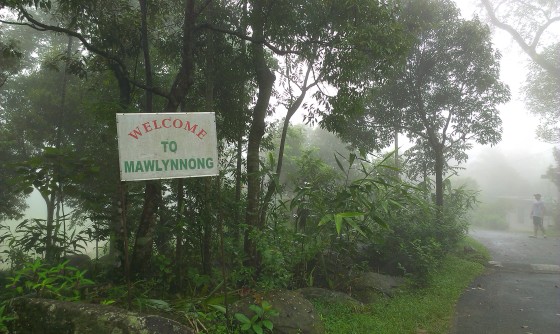It is true India is not one of the cleanest countries in the world. Leave cities, its villages are equally filthy. But what if I introduce you to a village where you’d be surprised to see no garbage! Yes, no garbage at all.
Mawlynnong, a small village located in the East Khasi Hills of Meghalaya is about 80 kms from Cherrapunje. The village is home to 90 families with total population of around 400. Having credited as the ‘cleanest village’ of Asia, Mawlynnong was on my list for long when I first heard about it. It was hard for me to believe the existence of such place in India. But it does exist.
The drive to this place is not only picturesque but quite an adventure since the road to it is blanketed by fog all throughout the year that makes tad difficult to drive. I always have a picture in my mind before visiting a place, however this village broke all notions. To reach to the interiors of the village we had to cut through the dense grassland. Since, it was pleasant weather I rolled down my window to feel the fresh breeze of the hills, and I could hear the loud buzzing of crickets.
It was pitch dark everywhere.
I asked our driver if it is always like this or is there a burnout? He replied that village has no streetlights. I was not surprised though.
As we were proceeding towards the village, we encountered men sitting on the road and drinking. Seeing me a bit puzzled, the driver told that it is normal here since there is no source of entertainment; people sit on the road and have ‘fun’.
Suddenly, the car stopped. I asked the driver why did he stop, we want to go to the village soon. He said, “this is it, this is the Mawlynnong village.” I was surprised because first, it was dark and second, it was dead, I could see nobody there. I checked my watch to see if we were late, but to my surprise it was just 7p.m.!!
This is how it looked in the morning

Photo Credits: TravelsandStories
We approached to our guesthouse that we had booked; the owner of the place was called Henry. Apparently, in Meghalaya, Christianity is predominant and almost all speak basic English! That was a breather. So, Henry showed us our bamboo hut that I was super excited to see. And it didn’t disappoint me a bit. The hut was a quaint cottage with two twin bedrooms, a common bathroom and dining area. Still basic but looked luxury in this small village.

Photo Credits: TravelsandStories
Henry told us that it is good if we leave to see the Riwai living root bridge early in the morning to beat any crowd what so ever.
Since it was too dark, I couldn’t have a first sight opinion of the village. And now, I anxiously waited for the morning. We all retired early after a long day.
The morning was even more beautiful than expected. A dewy morning with drizzle and I was awestruck by the greenery there. It was 6 a.m. and still did not see any village people.

Photo Credits: TravelsandStories
Riwai Living Root Bridge is located in Riwai Village, which is just a kilometer away from Mawlynnong. The bridge is another tale altogether and needs another post to be told.
On our way back to the cottage I finally saw local women cleaning the roads (which were already cleaned) and for the first time I noticed the cute bamboo triangular bins hung all around the village. These ubiquitous bins are the proofs of efforts taken by the locales to keep this place in tranquility with nature.

Photo Credits:TravelsandStories
I am sure you’d be mesmerize by the simplicity of the village to the extent that you might just start plan to spend your after retirement years there. Mawlynnong is an inspiration model to all the villages of India. It is so good to see when people respect nature and live in harmony with it. We have all read in schools about the importance of eco-balance but as we grow this knowledge holds little relevance. I was reintroduce to the concept again in this village and I could clearly make out how happy people there were. I just hope the credits of this village spread worldwide and inspire people to respect and preserve the nature. And believe me we don’t have a slightest idea how much a happy eco-system can give us back.
When to go:
Though it is still rainy season in August but it is the best time to see this beautiful village.
Where to stay:
If you are somebody who can’t leave his or her comfort zone, this place is not for you. There are no proper hotels here. There are only few bamboo huts owned by villagers, which are not advertised on Internet. Contact Henry (09615043027) or Carol (09436104844) for booking a bamboo hut.
Things to know:
- Since these bamboo huts are like homestays so only option to eat here is with the family. The food is basic but delicious and big portions.
- If you are a bit finicky about blankets, you can take your own since here the bedding would have a little damp stench. But you can’t complain.
- Check out the Tree House near the Bamboo Hut
- Since the village is all green, carry insect repellant.
- Carry rainproof cloths and footwear.
- Beware of leeches.
For more pics visit my flickr page : https://www.flickr.com/photos/travelzandstories/sets/72157646359037979/




